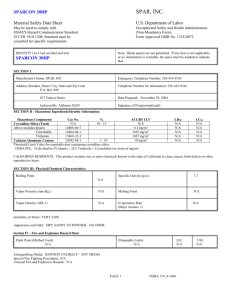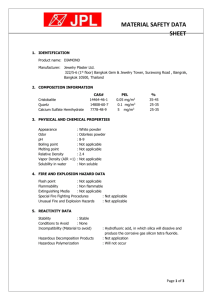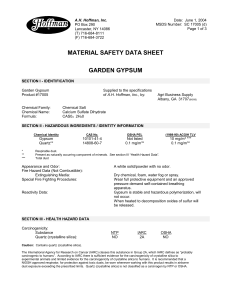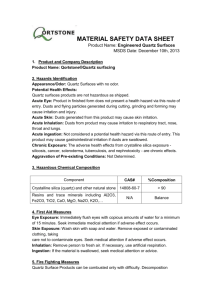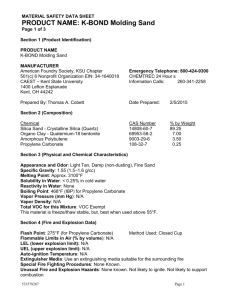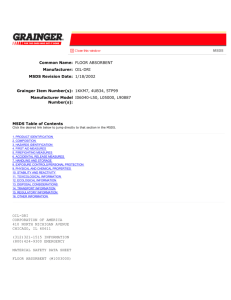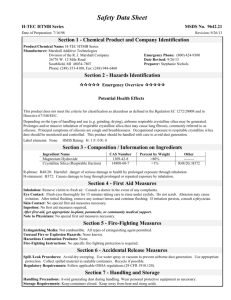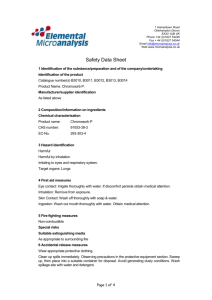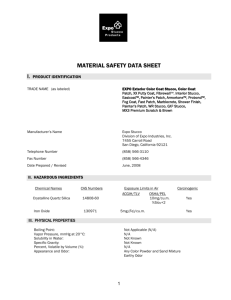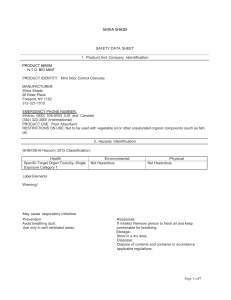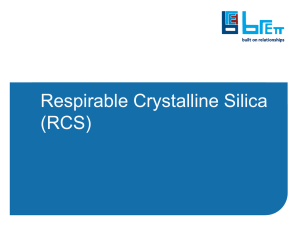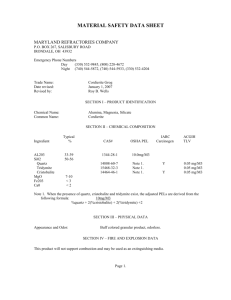Safety Data Sheet A - BioRok Technologies
advertisement
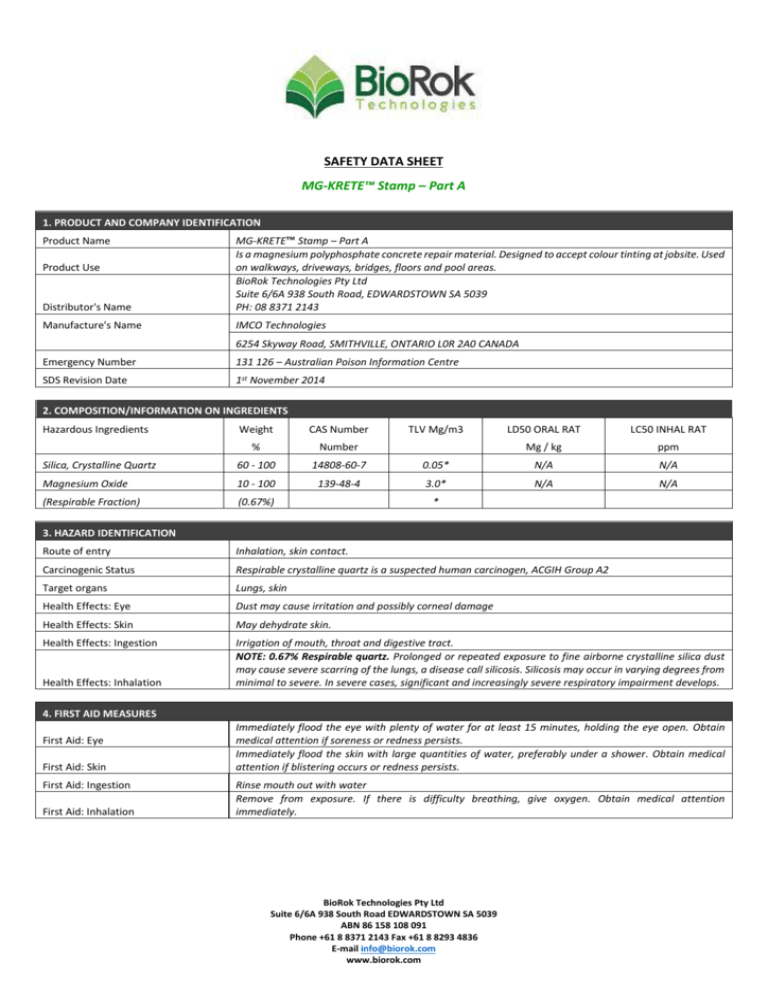
SAFETY DATA SHEET MG-KRETE™ Stamp – Part A 1. PRODUCT AND COMPANY IDENTIFICATION Distributor's Name MG-KRETE™ Stamp – Part A Is a magnesium polyphosphate concrete repair material. Designed to accept colour tinting at jobsite. Used on walkways, driveways, bridges, floors and pool areas. BioRok Technologies Pty Ltd Suite 6/6A 938 South Road, EDWARDSTOWN SA 5039 PH: 08 8371 2143 Manufacture's Name IMCO Technologies Product Name Product Use 6254 Skyway Road, SMITHVILLE, ONTARIO L0R 2A0 CANADA Emergency Number 131 126 – Australian Poison Information Centre SDS Revision Date 1st November 2014 2. COMPOSITION/INFORMATION ON INGREDIENTS Hazardous Ingredients Weight CAS Number % Number Silica, Crystalline Quartz 60 - 100 14808-60-7 Magnesium Oxide 10 - 100 139-48-4 (Respirable Fraction) (0.67%) TLV Mg/m3 LD50 ORAL RAT LC50 INHAL RAT Mg / kg ppm 0.05* N/A N/A 3.0* N/A N/A * 3. HAZARD IDENTIFICATION Route of entry Inhalation, skin contact. Carcinogenic Status Respirable crystalline quartz is a suspected human carcinogen, ACGIH Group A2 Target organs Lungs, skin Health Effects: Eye Dust may cause irritation and possibly corneal damage Health Effects: Skin May dehydrate skin. Health Effects: Ingestion Irrigation of mouth, throat and digestive tract. NOTE: 0.67% Respirable quartz. Prolonged or repeated exposure to fine airborne crystalline silica dust may cause severe scarring of the lungs, a disease call silicosis. Silicosis may occur in varying degrees from minimal to severe. In severe cases, significant and increasingly severe respiratory impairment develops. Health Effects: Inhalation 4. FIRST AID MEASURES First Aid: Eye First Aid: Skin First Aid: Ingestion First Aid: Inhalation Immediately flood the eye with plenty of water for at least 15 minutes, holding the eye open. Obtain medical attention if soreness or redness persists. Immediately flood the skin with large quantities of water, preferably under a shower. Obtain medical attention if blistering occurs or redness persists. Rinse mouth out with water Remove from exposure. If there is difficulty breathing, give oxygen. Obtain medical attention immediately. BioRok Technologies Pty Ltd Suite 6/6A 938 South Road EDWARDSTOWN SA 5039 ABN 86 158 108 091 Phone +61 8 8371 2143 Fax +61 8 8293 4836 E-mail info@biorok.com www.biorok.com 5. ACCIDENTAL RELEASE MEASURES Spill Procedures Non-reactive. Transfer into non-dusting sealed containers for recovery or disposal. Personal Precautions Avoid creation of dust. Wear NIOSH approved particle mark, gloves and eye protection. Environmental Precautions Stable in environment. Not toxic to wild life. 6. FIRE FIGHTING MEASURES Conditions of flammability Non-Flammable. Will not support combustion. Extinguishing media N/A Special hazards of product N/A Protective equipment for fire fighting N/A Flash point (PMCC) (oC) N/A Upper flammable limit % VOL N/A Lower flammable limit % VOL N/A Autoignition temp (oC) Explosion Data – Sensitivity to impact Explosion Data – Sensitivity to static discharge N/A No Yes 7. HANDLING AND STORAGE Handling Use in well-ventilated area. Use local exhaust ventilation. Avoid inhaling dust. Avoid contact with eyes, skin and clothing. Handle carefully to avoid creating dust. Storage Store in a dry area. 8. EXPOSURE CONTROLS/PERSONAL PROTECTION Use in well-ventilated area. Avoid creation of dust. Up to 0.5 mg/m3 use air purifying respirator with high efficiency particulate filter. Up to 1.25 mg/m3 use powered air purifying respirator with high efficiency Engineering Control Measures filter. Up to 2.5 mg/m3 use full-faced piece air purifying respirator with high efficiency particular filter. Respiratory Protection Wear NIOSH approved particle respirator. Hand Protection Gloves should be worn during all handling operations. Eye Protection Protect eyes from dust. Body Protection Clothing should cover body adequately to prevent exposure. Will release ammonia gas when mixed with 1260 Part B. Venting or respiration equipment may be required when working in confined spaces. After installation and drying, activities such as grinding, sawing or tear-out of material may cause dust concentration to be above the TLV limit for crystalline quartz. Protecting During Application 9. PHYSICAL AND CHEMICAL PROPERTIES Physical State Solid Odour & Colour None & Grey-buff Odour Threshold (ppm) N/A Specific Gravity 2.65 Vapour Density (AIR =1) Vapour Pressure = 20oC Evaporation Rate Boiling Range / Point Freezing Point N/A 10 mm @ 1730oC None (oC) (oC) 2230 N/A PH N/A Coefficient of water / oil distribution N/A Solubility In Water Insoluble VOC (G/L) 0 10. STABILITY AND REACTIVITY Stability Contact with strong oxidizing agents. Materials to avoid (incompatibility) Oxidizing agents: fluorine, chlorine trifluoride, manganese trioxide, oxygen difluoride. Hazardous Polymerization Will not occur. Hazardous Decomposition Products Silica will dissolve in hydrofluoric acid and produce a corrosive gas (silicon tetra fluoride). 11. TOXICOLOGICAL INFORMATION Effects of acute exposure N/A – No known acute toxicity. Effects of chronic exposure Repeated inhalation of concentrated free silica dust may cause delayed lung injury (silicosis). Exposure limits 0.05 mg/m3 Respirable quartz dust. Irritancy Mild irritation expected. Sensitisation Carcinogenicity Unlikely. The International Agency for Research on Caner has concluded that crystalline silica in the form of quartz from occupational exposures should be classified as carcinogenic to humans (Group 1) The American Conference of Government Industrial Hygienists have given crystalline silica, quartz an A2 classification, suspected human carcinogen. Simultaneous exposure to known carcinogens can increase carcinogenicity of crystalline silica. Reproductive toxicity N/A Teratogenicity N/A Mutagenicity N/A Toxicologically synergistic products Synergistic effect between smoking and crystalline silica is likely. 12. ECOLOGICAL INFORMATION Mobility Stable in environment. Persistence / Degradability Non-biodegradable, generally non-toxic. Bio-Accumulation Product does not bio-accumulate. Eco toxicity Not toxic to wild life. 13. DISPOSAL CONSIDERATIONS Product Disposal Non-reactive. Transfer into non-dusting, sealed containers for recovery or disposal. Dispose of in an approved landfill site. Contact local authorities for disposal approval. Container Disposal Empty bags may contain hazardous residues. Dispose of bags with care. 14. REGULATORY INFORMATION WHMIS Classification Class D, Div.2, Subdivision A –Very Toxic Material CEPA Status (DSL) All of the ingredients of this product are listed on the Domestic Substances List This product has been classified in accordance with the hazard criteria of the Controlled Products Regulations (CPR) and the MSDS contains all the information required by CPR. 15. TRANSPORTATION INFORMATION CANADA TDG Classification Hazard Label: Not Required Not Regulated EXPORT DOT CFR 172.101 Data Not Regulated UN Proper Shipping Name N/A UN Class N/A UN Number N/A UN Packaging Group N/A Flash Point N/A Hazardous Material N/A Hazardous Label N/A 16. OTHER INFORMATION Hazard Rating 0 = Minimal; 1 = Slight; 2 = Moderate; 3 = High; 4 = Extreme Health = 1 Flammability = 0 Reactivity = 0 Abbreviations N/A: Denotes no applicable information found or available CAS#: Chemical Abstracts Service Number ACGIH: American Conference of Governmental Industrial Hygienists OSHA: Occupational Safety and Health Administration TLV: Threshold Limit Value PEL: Permissible Exposure Limit STEL: Short Term Exposure Limit NTP: National Toxicology Program IARC: International Agency for Research on Cancer R: Risk S: Safety LD50: Lethal Dose 50% LC50: Lethal Concentration 50% Prepared By IMCO Technologies Inc. Provided data is offered in good faith as typical values and not as a product specification. No warranty, either express or implied, is hereby made. The recommended industrial hygiene and safe handling procedures and believed to be generally applicable, however, each user should review these recommendations.
